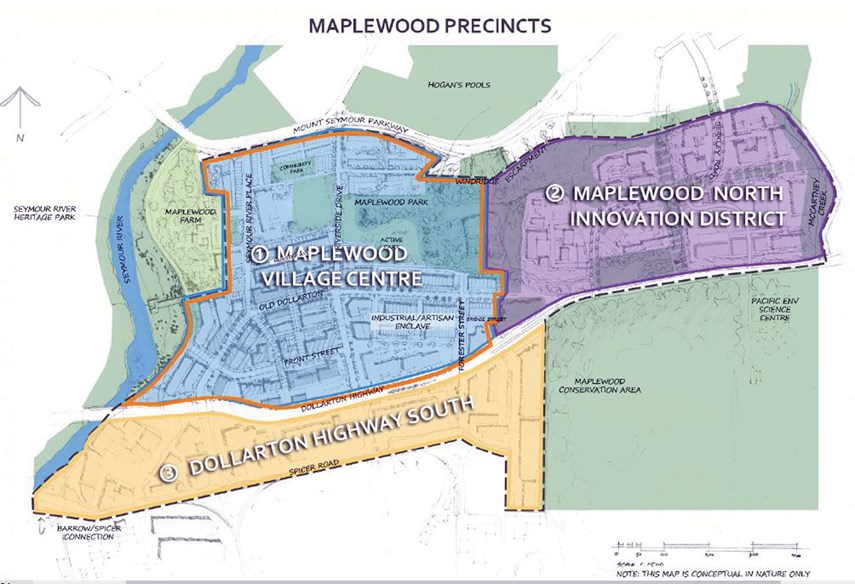District of North Vancouver council has given its first tentative thumbs-up to a broad-scoped plan that will bring significant change to the Maplewood neighbourhood.
Council voted 4-2 Monday night to approve the draft Maplewood community plan, the last of the four “village centres” in the district that are intended to take 75 to 90 per cent of all residential growth over 30 years.
The vision supports the goal of the district’s 2011 official community plan, which is to create “complete” communities where residents can get to work, shop, access services or learn without having to travel by car.
At full build-out, Maplewood’s plan would mean 1,500 new condos and townhouses on the 80 hectares of land east of the Seymour River between Mount Seymour Parkway and Dollarton Highway, along with 36 acres of expanded light-industrial land, 100,000 square feet of commercial space and a tech-focused “innovation district.”
Most of the housing development would be in low- and mid-rise form, up to six storeys, although towers could reach as high as 12 storeys at the village core at Old Dollarton Road and Riverside Drive.
Of the new units, at least 300 should be affordable or below-market housing, according to staff. Staff say the district can achieve this through density bonusing, community amenity contributions and by offering up some of its own “substantial” land holdings in the plan area.
About 900 of the housing units would be within the innovation district, according to staff, and would be reserved for those who work in the nearby businesses. At least half of those homes should be “non-market” as well, according to staff, as a condition of rezoning.
The plan anticipates 4,500 new employees working in roughly 130 new business spaces on one million square feet of space in the Maplewood neighbourhood by 2030.
But carrying the plan out would come at the expense of 250 older, purpose-built rental apartments in the area and their residents who would be demovicted. Additionally, 16 existing businesses would be displaced and about 40 acres of trees would be cut.
The plan also includes new parks, pathways and bike lanes, an extension of Berkley Road between Seymour and Dollarton, protection of environmentally sensitive areas and environmental remediation of former industrial sites, daycare centres and public art.
The plan has been in development and consultation since 2015, but the desire for change there goes back more than a decade, Mayor Richard Walton said, noting when he first ran for mayor 12 years ago, he campaigned on creating a plan for Maplewood. “I think the time is now. I’ve seen delay and delay,” he said.
Coun. Mathew Bond agreed. “I think it’s really important now to seize the opportunity we have to make a more flexible environment in the district for businesses to come set up shop, to hire employees and for those employees to have a place to live close to where they work. These are the principles that the official community plan and the town centre plans are built on,” he said.
There was dissent, however. Coun. Jim Hanson said the plan had some good elements that could be salvaged but he could not support the prospect of more traffic and fewer trees.
“In my most respectful view, the consultation process was tainted by a pro-development bias and the real view of the community has not been presented to this council,” he said. “It glosses over serious transportation issues, resorts to wishful thinking with respect to the arrival of b-lines and other transportation infrastructure. On its face, we’re talking about importing 1,500 residences into a region in the Lower Mainland which is at a critical transportation failure.”
Coun. Robin Hicks saw things differently. “We need to provide housing for our young people, retirees and our workforce and dragging our feet will mean higher real estate and diminished economic activity. And traffic congestion on our highways will continue to increase whether we, as a district, grow or not because most of the congestion is due to the fact that we’re on a provincial highway and it’s accessed by people on both ends and from the Island.”
Coun. Lisa Muri joined Hanson in voting against the plan, largely on the grounds that it included too much market housing. “I support affordable housing and we have a dismal, dismal track record on creating new affordable housing but we are really, really good at building market condos,” she said, suggesting the district focus just on building affordable units on its own land.
Coun. Doug MacKay-Dunn acknowledged the plan’s flaws, but he added, it isn’t chiseled in stone. Council can continue to refine and amend it for the better as individual applications for rezoning by developers come forward. “It’s not perfect but we can’t let perfect be the enemy of the good. And I think this is a good start,” he said.
Don Peters, chairman of the North Shore Community Resources’ community housing action committee, said after a thorough vetting of commitments to a net increase of affordable housing, he could endorse the plan. “Overall, (the committee) is encouraged about this plan, despite the desperate prospects for many people who wish to live and work and raise families and even grow old here like many of us in this room who have been fortunate enough to do so,” he said.
Staff from several development firms sat in the council gallery waiting for the outcome of the vote.
Coun. Roger Bassam wasn’t present for Monday’s meeting.



